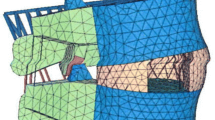Abstract
One goal of interbody fusion is to increase the height of the degenerated disc space. Interbody cages in particular have been promoted with the claim that they can maintain the disc space better than other methods. There are many factors that can affect the disc height maintenance, including graft or cage design, the quality of the surrounding bone and the presence of supplementary posterior fixation. The present study is an in vitro biomechanical investigation of the compressive behaviour of three different interbody cage designs in a human cadaveric model. The effect of bone density and posterior instrumentation were assessed. Thirty-six lumbar functional spinal units were instrumented with one of three interbody cages: (1) a porous titanium implant with endplate fit (Stratec), (2) a porous, rectangular carbon-fibre implant (Brantigan) and (3) a porous, cylindrical threaded implant (Ray). Posterior instrumentation (USS) was applied to half of the specimens. All specimens were subjected to axial compression displacement until failure. Correlations between both the failure load and the load at 3 mm displacement with the bone density measurements were observed. Neither the cage design nor the presence of posterior instrumentation had a significant effect on the failure load. The loads at 3 mm were slightly less for the Stratec cage, implying lower axial stiffness, but were not different with posterior instrumentation. The large range of observed failure loads overlaps the potential in vivo compressive loads, implying that failure of the bone-implant interface may occur clinically. Preoperative measurements of bone density may be an effective tool to predict settling around interbody cages.
Similar content being viewed by others
Author information
Authors and Affiliations
Additional information
Received: 3 July 1997 Revised: 18 September 1997 Accepted: 26 September 1997
Rights and permissions
About this article
Cite this article
Jost, B., Cripton, P., Lund, T. et al. Compressive strength of interbody cages in the lumbar spine: the effect of cage shape, posterior instrumentation and bone density. E Spine J 7, 132–141 (1998). https://doi.org/10.1007/s005860050043
Issue Date:
DOI: https://doi.org/10.1007/s005860050043




